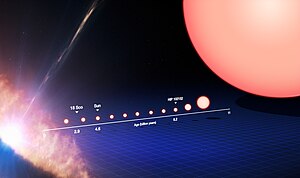astro.wikisort.org - Star
HD 197027 (HIP 102152) is a star in the constellation Capricornus. It has an apparent magnitude of 9.15,[2] making it readily visible through a telescope but not to the naked eye. The object is located at a distance of 255 light years but is approaching the Solar System with a heliocentric radial velocity of −44 km/s.[5]
| Observation data Epoch J2000.0 Equinox J2000.0 (ICRS) | |
|---|---|
| Constellation | Capricornus |
| Right ascension | 20h 41m 54.6336s[1] |
| Declination | −27° 12′ 57.4154″[1] |
| Apparent magnitude (V) | 9.15±0.02[2] |
| Characteristics | |
| Spectral type | G3 V[3] |
| U−B color index | +0.30[4] |
| B−V color index | +0.65[2] |
| Astrometry | |
| Radial velocity (Rv) | −43.9±0.3[5] km/s |
| Proper motion (μ) | RA: +175.628[1] mas/yr Dec.: −15.593[1] mas/yr |
| Parallax (π) | 12.7715 ± 0.0164 mas[1] |
| Distance | 255.4 ± 0.3 ly (78.3 ± 0.1 pc) |
| Absolute magnitude (MV) | 4.74[6] |
| Details | |
| Mass | 0.97[7] M☉ |
| Radius | 1.08+0.07 −0.05[8] R☉ |
| Luminosity | 1.19[6] L☉ |
| Surface gravity (log g) | 4.40±0.02[9] cgs |
| Temperature | 5718±5[9] K |
| Metallicity [Fe/H] | −0.020±0.005[9] dex |
| Rotational velocity (v sin i) | 1.78±0.12[9] km/s |
| Age | 6.92±0.69[9] Gyr |
| Other designations | |
| Database references | |
| SIMBAD | data |
HD 197027 has a stellar classification of G3 V, indicating that it is an ordinary G-type main-sequence star like the Sun. It has only 97% the mass of the Sun[7] but 108% of its radius.[8] It shines at 119% the luminosity of the Sun[6] from its photosphere at an effective temperature of 5,718 K,[9] similar to the Sun's 5,778 K. HD 197027's metallicity – elements heavier than helium – is similar to the Sun.[9] At an older age of 6.92 billion years, it spins with a projected rotational velocity of about 2 km/s.[9]
Since its measured properties of this star are very similar to those of the Sun, it has been considered a candidate older solar twin.[11] The abundances of 21 elements overall are more similar to the Sun than any other known solar twin. [citation needed] A
Age

References
- Brown, A. G. A.; et al. (Gaia collaboration) (2021). "Gaia Early Data Release 3: Summary of the contents and survey properties". Astronomy & Astrophysics. 649: A1. arXiv:2012.01533. Bibcode:2021A&A...649A...1G. doi:10.1051/0004-6361/202039657. S2CID 227254300. (Erratum: doi:10.1051/0004-6361/202039657e). Gaia EDR3 record for this source at VizieR.
- Høg, E.; Fabricius, C.; Makarov, V. V.; Urban, S.; Corbin, T.; Wycoff, G.; Bastian, U.; Schwekendiek, P.; Wicenec, A. (March 2000). "The Tycho-2 catalogue of the 2.5 million brightest stars". Astronomy and Astrophysics. 355: L27–L30. Bibcode:2000A&A...355L..27H. ISSN 0004-6361.
- Houk, N. (1982). Michigan Catalogue of Two-dimensional Spectral Types for the HD stars. Volume_3. Declinations -40_ƒ0 to -26_ƒ0. Bibcode:1982mcts.book.....H.
- Paunzen, E. (May 2022). "Catalogue of stars measured in the Geneva seven-colour photometric system". Astronomy & Astrophysics. 661: A89. arXiv:2111.04810. Bibcode:2022A&A...661A..89P. doi:10.1051/0004-6361/202142355. eISSN 1432-0746. ISSN 0004-6361.
- Gontcharov, G. A. (November 2006). "Pulkovo Compilation of Radial Velocities for 35 495 Hipparcos stars in a common system". Astronomy Letters. 32 (11): 759–771. arXiv:1606.08053. Bibcode:2006AstL...32..759G. doi:10.1134/S1063773706110065. eISSN 1562-6873. ISSN 1063-7737. S2CID 119231169.
- Anderson, E.; Francis, Ch. (May 2012). "XHIP: An extended hipparcos compilation". Astronomy Letters. 38 (5): 331–346. arXiv:1108.4971. Bibcode:2012AstL...38..331A. doi:10.1134/S1063773712050015. ISSN 1063-7737.
- Talawanda R. Monroe; et al. (Aug 2013). "High Precision Abundances of the Old Solar Twin HIP 102152: Insights on Li Depletion from the Oldest Sun". Astrophysical Journal Letters. 774 (2): L32. arXiv:1308.5744. Bibcode:2013ApJ...774L..32M. doi:10.1088/2041-8205/774/2/l32. S2CID 56111132.
- Stassun, Keivan G.; et al. (9 September 2019). "The Revised TESS Input Catalog and Candidate Target List". The Astronomical Journal. 158 (4): 138. arXiv:1905.10694. Bibcode:2019AJ....158..138S. doi:10.3847/1538-3881/ab3467. ISSN 0004-6256.
- dos Santos, Leonardo A.; et al. (August 2016), "The Solar Twin Planet Search. IV. The Sun as a typical rotator and evidence for a new rotational braking law for Sun-like stars", Astronomy & Astrophysics, 592: 8, arXiv:1606.06214, Bibcode:2016A&A...592A.156D, doi:10.1051/0004-6361/201628558, S2CID 53533614, A156.
- "HD 197027". SIMBAD. Centre de données astronomiques de Strasbourg. Retrieved 2013-09-07.
- ESO, The life cycle of a Sun-like star (annotated), from European Southern Observatory, 28 August 2013
External links
- Oldest Solar Twin Identified
- HIGH PRECISION ABUNDANCES OF THE OLD SOLAR TWIN HIP 102152: INSIGHTS ON LI DEPLETION FROM THE OLDEST SUN
- Oldest Solar Twin Identified
На других языках
[de] HIP 102152
HIP 102152 (HD 197027) ist ein rund 250 Lichtjahre entfernter Stern im Steinbock. In vielerlei Hinsicht ist er der Sonne sehr ähnlich, jedoch mit dem Unterschied eines wesentlich höheren Alters.- [en] HD 197027
[ru] HD 197027
HD 197027 — одиночная звезда главной последовательности в созвездии Козерога. Находится в 250 световых годах от Солнца.Другой контент может иметь иную лицензию. Перед использованием материалов сайта WikiSort.org внимательно изучите правила лицензирования конкретных элементов наполнения сайта.
WikiSort.org - проект по пересортировке и дополнению контента Википедии
